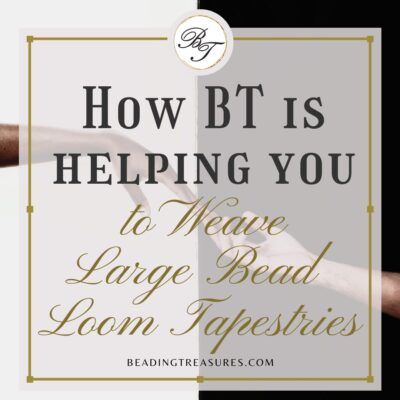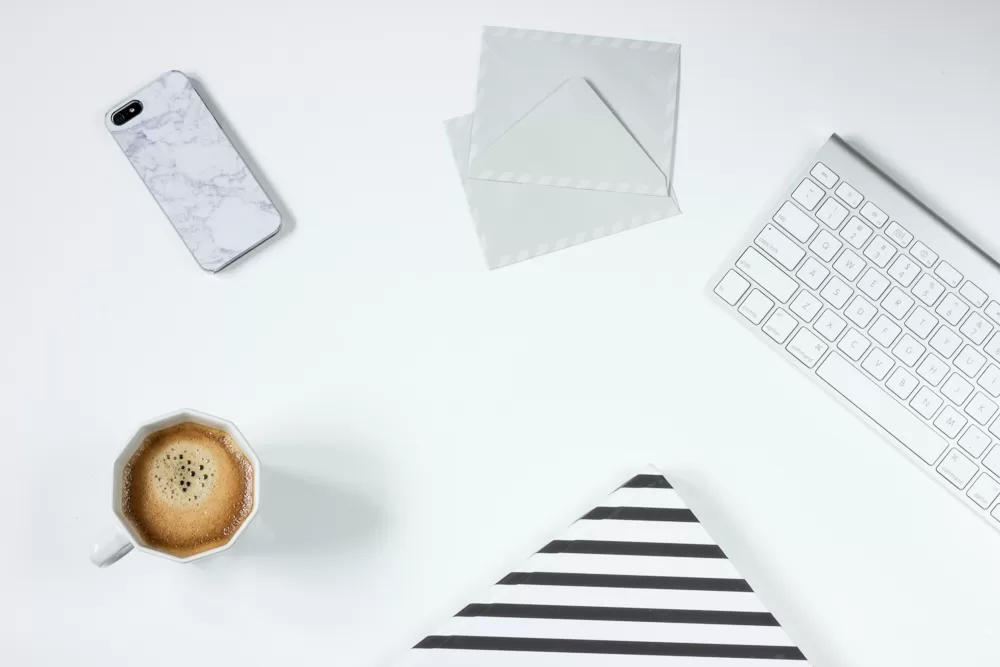Design
What to Look for Before Purchasing a Pattern
Follow us on
When purchasing a pattern for tapestries it is hard to know which one to chose, other than the fact that you like the image of course. There are so many things to consider and especially the expense of the beads themselves.
But the pattern is the first step, after which comes the labour of love… that of making your beaded treasure.
The purpose of this post is to help you with the selection process of your pattern.
It is geared to help you start off on the right foot.
So, here we go…
What to look for in a Pattern
Here are the main things I look for when purchasing a pattern or even downloading a free one.
- The interpretation of the colours and finishes of the beads
- The clarity and beauty of any completed tapestries
- Reviews and comments by customers
- What is in the patterns, for example, grid or word chart, etc?
- The kind of beads used, for example, Delica
- The number of bead colours needed for the pattern
Let’s take these sections one by one and break them down.
But first… Lemme say that you might find some patterns to download on Pinterest for free and cross-stitch patterns are more common than bead loom patterns. Any Patterns on Etsy and Artfire are available for purchase only.
Here we go…
1. The Interpretation of the Colours and Finishes of the Beads
It is easier to design for cross stitch than for beadwork, the main reason being the finish and luminosity of the beads themselves.
Thread colours and bead colours just don’t translate the same.
For the sake of clarity, we will assume that the cross stitch designs all call for DMC thread. There are several other brands but DMC is a very popular one.
Let’s say I wanted to design a cross stitch pattern using a particular photo. I will use a Cross Stitch program that will import that photo and then convert it into cross stitch stitches with their corresponding DMC thread colours.
After that small adjustments will have to be made to fix the design a bit, maybe eliminate or merge some colours and then the pattern is done and ready to be used.
For a bead-woven tapestry, I will import the image I want to use into Beadtool4 let’s say, and then make all the necessary changes as with the cross stitch but then go back and check every bead colour if it works in the pattern.
So if you are choosing a cross-stitch pattern to use please keep in mind that you need to check the colour of the beads and how they play together, also be aware of how the cross stitch pattern converts into beads.
Remember… beads are taller than they are wide, whereas in cross stitch as on the grid, each stitch is a perfect square.
2. The Clarity and Beauty of any Completed Tapestries
In the case where the particular pattern you are interested in has not been woven, have a look at previous tapestries that have been woven by a designer. They will give you an idea of the skill and talent of the designer in designing the pattern and also choosing the right colour and finish of the beads themselves.
Here is what to look for:
Proportions of the tapestry
Is the completed tapestry too wide or too long? This will happen if the designer has not adjusted for the size of the beads which do not have the same width-to-height ratio.
Clarity of Colour
Is there a clear contrast between the colours used so that the shapes are evident where they need to be in the tapestry? Can you see the picture clearly without straining to tell what it is?
Random Beads
Are there stray beads where there shouldn’t be? Stray beads look a bit like dust specks in a photo. When odd beads stand out for no particular purpose. This means that care has not been taken during the editing process of the pattern.
These are only a few things to look for but they are a good start.
3. Reviews and Comments by Customers
Have a look at reviews left by people who have purchased these patterns or other patterns from the same designer.
See what their opinion and experience were like.
There is so much you can learn from reviews.
Check for the kind of support that was made available after purchase.
4. What is in the Patterns, Grid or Word Chart, etc?
It all depends on how you weave on the loom, personally, I use a grid and I prefer symbols to alphanumeric characters for many reasons. But you might not so check if the pattern is available in the format you need.
Grid
When using a grid, it does not matter so much if your style of looming is left to right or right to left, or bottom-up or top-down.
Word chart
Some prefer word charts as it helps with the counting of the beads. For word charts, it is much easier to have them in the style or method of your looming say for example top to bottom, right to left.
Symbols or Alphanumeric Characters
Some charts come with numbers and letters of the alphabet, others come with symbols. This is true for the word charts as well. Make sure the charts are in a format that you will be comfortable working with. This will help with enjoying the process of the weaving itself.
Colour Chart
Colour Charts are also known as Colour Legends. Having one in a pattern is a must for me… especially with the higher number of colours called for in larger tapestries.
Here are some examples of Colour Charts
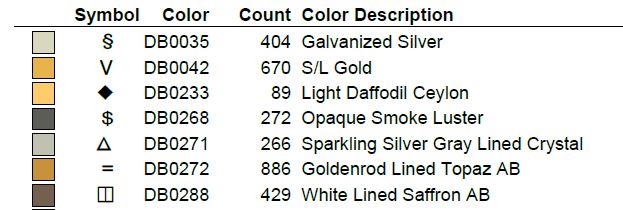
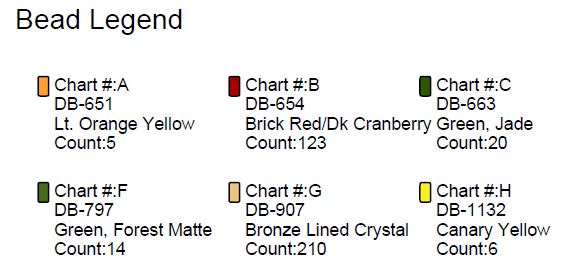
This kind of chart or legend will have a list of:
-The symbol or character of the colour in the chart
-The ID number of the bead colour. Here the beads are Delicas size 11/0.
-The name of the bead colour
-The number of beads used in the chart. This will help you calculate the weight of the beads needed per colour, in case it is not given by the designer.
5. The Kind of Beads Used
What kind of beads does the designer use or the pattern calls for?
This is important because using different kinds of beads gives a different end result.
Also, a good reason to check the kind of beads is so that you can use up what you have in your stash and minimize the purchase and expense of new beads.
Round Beads vs Cylinder Beads
This deserves a post of its own. I’ll be covering this in another post and when I do I will link back to it here.
6. The Number of Bead Colours Needed
If the number of bead colours is really high compared to the image and the size of the tapestry then that may be a sign the designer did not do a thorough job. But to be fair, sometimes especially in smaller tapestries, the designer may need to use more colors for the image to be clear.
One Final Note…
The methods I have outlined are just a guide really. They are meant to make your pattern selection easier and with time and experience, you will know what kind of patterns and designers are the best for you.
At the end of the day, beauty is subjective.
So… if a particular pattern resonates with you… Go for it!!
If you enjoyed this post…
You might also like to read these posts too:
lATEST POSTS
Best Thread Color to Use with your Patterns
What is the best thread and thread color to use for weaving your bead tapestry?
Dec
Best Way to Weigh Your Beads
How best to go about weighing the beads in your stash before purchasing more for[...]
Dec
How BT is Helping You to Weave Large Bead Loom Tapestries
All things beading, bead looming large tapestries and digital planning for beaders.
Mar
Hi there ! I’m Nedal.
I created Beaded Treasures to make information about beading large tapestries more accessible, and in doing so encourage the creation of this amazing art form.
Weaving big can seem intimidating but by using some techniques it is totally doable, no more than that it is really enjoyable!
If you’ve found this blog helpful, please support me by choosing the affiliate products on my blog and following me on my social platforms.
Don’t forget to check out the shop.
Thank you!
Nedal Douaihy, Artist & Founder

What to look for before purchasing a pattern
- What to look for in a Pattern
- 1. The Interpretation of the Colours and Finishes of the Beads
- 2. The Clarity and Beauty of any Completed Tapestries
- 3. Reviews and Comments by Customers
- 4. What is in the Patterns, Grid or Word Chart, etc?
- 5. The Kind of Beads Used
- 6. The Number of Bead Colours Needed
- One Final Note…
- If you enjoyed this post…
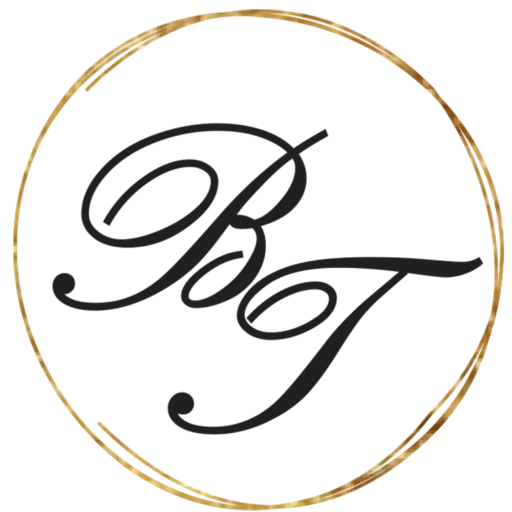

![BLOG COVER [What to look for before Purchasing a Pattern]](https://beadingtreasures.com/wp-content/uploads/2021/02/BLOG-COVER-What-to-look-for-before-Purchasing-a-Pattern-800x800.jpg)


